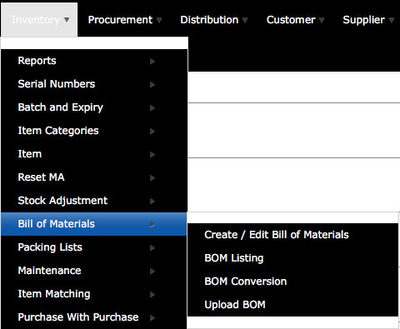Bill of Materials
Every bill of material consist of at least ONE parent item code, and AT LEAST ONE child item codes in any ratios. As each child item code can again be defined as a combination of other child item codes, this gives the user the unlimited depth/level while specifying the Bill Of Materials.
Display logic for Child item:
1. Display Row
When this option is selected, the system will retrieve the item code and item name of the child items themselves while displaying this item in a document.
2. Replace Text
If this option is selected, the system will make use of the pseudo item code and product name while displaying the child item of a package.
Various ways to use the Bill of Materials in Wavelet EMP:
1. Packages
In some businesses, when customers are buying a product, it may consist of a number of items, and these items need to be shown on the bill, while others within this package should be hidden. For item that are shown, users could define the detailed breakdown of the prices for each of the items, or they could define the lump sum figure and assign this amount to one of the items within the Bill Of Materials. Hidden items are useful in cases where these stocks need to be deducted in the inventory when a package is being sold, but they are not meant to show in the invoice.
Packages are used when invoices and sales order should display the composition of the packages. If only the finished product code itself (which is the package code) are to be displayed in the bill, users should consider using the Bill of Materials to convert the item codes so that the breakdown of inventory could be deducted in a separate function.
2. Pseudo Item Code and Product Name
Pseudo codes and pseudo product names are very useful in industry where the real identity of the stock or material should be hidden from the customers. This is a very powerful tool to protect commercial secret, as well as to sell the same product to different customers based on different product range. Very often, the same product could be used in multiple packages. And each of these packages, despite using some of the same stocks, fetch different prices when sold as different names. By disguising the real item codes and item names of the products, merchants are able to increase their profit margin and offer a wide range of products and services.
3. Conversion of Item Codes
For businesses that process raw materials into work in progress, and subsequently finished products, conversion of item codes are part and parcel of the daily operations. Bill of Material could be convert a parent item code into child item codes based on the ratio specified, or merge the child item codes into the parent item codes.
Most often than not, businesses choose to do item conversion instead of packages because they would prefer the process to be done separately, as oppose to "Packages" above, where every child item codes will be included in the invoice/sales order.
4. Short Cut or Short Hand
For some businesses, especially servicing companies, it may be useful to outline the detailed of the services in great length, simply to make the invoices or cash sale look more presentable. With bill of materials, the frequently used packages could be populated into the invoice or sales order conveniently.
Private & Confidential
